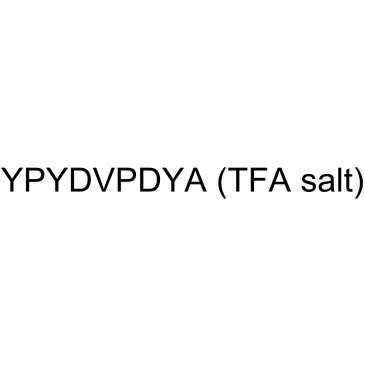HA Peptide TFA |
| Catalog No.GC61964 |
HA Peptide (TFA) is a nine amino acids peptide derived from the human influenza hemagglutinin (HA).
Products are for research use only. Not for human use. We do not sell to patients.

Sample solution is provided at 25 µL, 10mM.
HA Peptide (TFA) is a nine amino acids peptide derived from the human influenza hemagglutinin (HA). HA Peptide (TFA) is extensively used to isolate, purify, detect, and track the protein of interest in cell biology and biochemistry[1][2][3].
HA Peptide is a highly immunoreactive tag generally used for the separation of tagged proteins from cell culture supernatants and cell lysate under neutral pH conditions and thus are handy tools for coimmunoprecipitation but are also easily detected via western blot. HA Peptide is small and thus unlikely to interfere with the bioactivity and function of the fusion partner proteins. HA Peptide comes from human influenza hemagglutinin (HA) corresponding to amino acids 98-106 and is a strong immunoreactive epitope making it popular to isolate, purify, detect, and track the protein of interest. The recombinant HA-tagged proteins can be separated by highly specific anti-HA monoclonal antibody that is covalently immobilized on resin. The HA-tagged proteins can be eluted by mild elution approach with HA epitope at 1 mg/mL in TBS. On the other hand, three chemical elution options are available: 0.1 M glycine (pH 2-2.8), 3 M NaSCN, or 50 mM NaOH[1]. The nucleotide sequences encoding an N-terminal HA Peptide in the mammalian expression vectors is an essential element for the T7 promoter-driven expression in E. coli even without trans-acting T7 RNAP[2]. Research results suggest that HA Peptide is cleaved by caspase 3/7, and HA Peptide cleavage results in a total loss of immunoreactivity. Observations indicate that the use of HA to tag proteins and constructs to study cell death-related and apoptotic mechanisms can result in serious artifacts[3].
References:
[1]. Zhao X, et, al. Several affinity tags commonly used in chromatographic purification. J Anal Methods Chem. 2013;2013:581093.
[2]. Moon JM, et, al. A new idea for simple and rapid monitoring of gene expression: requirement of nucleotide sequences encoding an N-terminal HA tag in the T7 promoter-driven expression in E. coli. Biotechnol Lett. 2012 Oct;34(10):1841-6.
[3]. Schembri L, et, al. The HA tag is cleaved and loses immunoreactivity during apoptosis. Nat Methods. 2007 Feb;4(2):107-8.
Average Rating: 5 (Based on Reviews and 8 reference(s) in Google Scholar.)
GLPBIO products are for RESEARCH USE ONLY. Please make sure your review or question is research based.
Required fields are marked with *




















